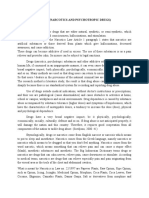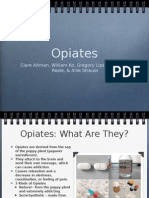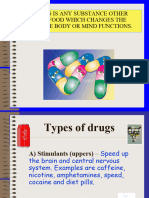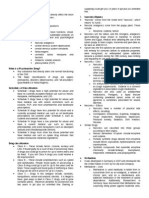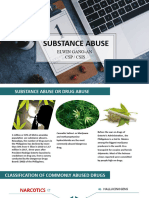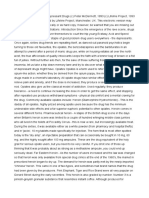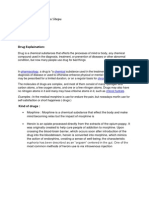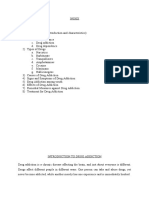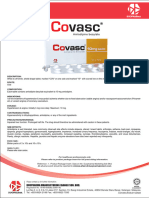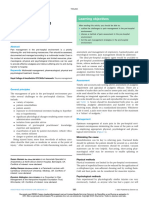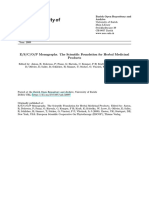NARCOTICS TYPES
Submitted to: Sir Muhammad Adnan
By
Muhammad Usama Khan-009
Department: B.S. Chemistry
Session: 2016-2020
Semester: 8th
�Analytical Chemistry
Contents:
What is Narcotic?
What Are Narcotics Used For?
Are Narcotics Addictive?
Commonly Abused Narcotics & Opioids
• Opium
• Heroin
• Codeine
• Oxycodone
• Hydrocodone
• Tramadol
• Morphine
• Hydromorphone
• Fentanyl
• Carfentanil
Reference
1
�Analytical Chemistry
What is Narcotic?
Narcotic is a drug that produces analgesia (pain relief), narcosis (state of stupor or sleep), and addiction
(physical dependence on the drug). In some people narcotics also produce euphoria (a feeling of great
elation).
What Are Narcotics Used For?
Narcotics have some valid medical uses, including:
• Pain management
• Anesthesia
• Reduction of respiratory distress for the dying
• Sedation
• Anti-diarrheal
• Antitussives (cough suppressant)
• Treatment of withdrawal and cravings in opioid-dependent individuals
• Lowering blood pressure and reducing fluid flow through the heart during an acute heart attack
Narcotics are abused for their euphoric effects.
Are Narcotics Addictive?
Narcotics are highly addictive. Besides their intended effects of attenuating pain, they also cause some
abnormal chemical changes in the brain that activate the brain’s reward system.
The brain has a system for rewarding people for positive behaviors, such as when we get a good meal
when we are hungry or achieve something else necessary for survival. To encourage such necessary
behaviors, the brain releases “feel-good” chemicals (neurotransmitters) that make us feel good when we
achieve them.
Narcotics release huge amounts of neurotransmitters — about ten times that released by sex — which is
why people who use the drugs feel high. Addiction occurs because this reward system has its intended
effect: it gets the individual to repeat the behavior that resulted in the reward, in this case, the drug use.
2
�Analytical Chemistry
As individuals are driven to use the narcotics repeatedly, tolerance develops. This is where it takes
increasing amounts of the narcotics to get the same effect. Tolerance is a major feature of addiction and
the main cause of the escalating drug use that is typical of addiction.
Another feature of addiction is withdrawal. When drug use stops, uncomfortable symptoms and cravings
result. As tolerance develops, people who are addicted to narcotics get very little high from their drug use.
Their continued use is largely to avoid withdrawal symptoms.
Commonly Abused Narcotics & Opioids
Below is a brief list of some of the more widely-known narcotics and opioids drugs:
• Opium
• Heroin
• Codeine
• Oxycodone
• Hydrocodone
• Tramadol
• Morphine
• Hydromorphone
• Fentanyl
• Carfentanil
1. Opium
For years, opium was a widely-used drug derived from the crude botanical extract extruded from the
opium poppy plant. With minimal processing, opium consisted of a mixture of naturally-occurring opiate
alkaloids—substances that serve as the building blocks for the synthesis of many modern opioid drugs.
Opium was sometimes distributed as a liquid or solid, but most commonly encountered as a brownish
3
�Analytical Chemistry
powder, according to the DEA. Opium was most commonly smoked but could also be pressed into pill
form or dissolved into a tincture or other solution for oral use or injection.
The opioid alkaloids contained in opium extracts (e.g., codeine, morphine, thebaine) are used to synthesize
many prescription narcotics (like morphine, codeine, oxycodone, etc.). Heroin is also made from raw
materials obtained from the opium poppy plant. Opium is not as common a drug of abuse in the United
States as other opioids are, and outside of limited use as an anti-diarrheal agent, has no medical use in its
traditional form.
2. Heroin
An illegal, semi-synthetic opiate, heroin is classified as a Schedule I controlled substance in the United
States, as it has no approved medical uses and a high potential for abuse and addiction. Opioids like heroin
dull pain but can also impair cognition, increase sedation, and slow certain autonomic functions such as
those that control respiratory rate. Heroin may be distributed as a brown or white powder or a sticky black
substance called “black tar heroin.” The drug can be snorted, smoked, or injected. Heroin creates an
intense and rapid “high” or “rush,” and individuals often cycle between an awake and unconscious state,
called being “on the nod.”
Overdose is a major risk of abuse. The rate of heroin overdose deaths increased by nearly 20 percent from
2015 to 2016, and close to 15,500 people died from drug overdoses involving heroin in 2016. Heroin
overdose symptoms may include markedly constricted pupils, difficulties breathing, respiratory arrest,
stupor, sluggish movements, confusion, clammy and cold skin, slow heart rate and low blood pressure, a
bluish tinge to the nails and lips, and a potential loss of consciousness. Heroin overdose is a medical
emergency; if an overdose is suspected, call 911 immediately.
3. Oxycodone (OxyContin, Roxicodone, and Percocet)
One of the most popular and arguably one of the most controversial drugs in recent history, OxyContin is
an extended-release formulation of oxycodone that has made more than $35 billion in sales for Purdue
4
�Analytical Chemistry
Pharma since it burst onto the market with aggressive marketing strategies in 1995, Forbes reports. Purdue
has paid out millions for its alleged role in the opioid addiction epidemic currently sweeping across
America.
OxyContin and other opioids containing oxycodone are effective painkillers for moderate to severe pain;
however, they can quickly lead to the development of physical dependence and addiction with regular use
or abuse. In its various formulations, oxycodone is dispensed as both immediate and extended-release
tablets intended for oral use. Oxycodone is also available in several combination formulations that include
analgesic pain relievers such as acetaminophen and aspirin.
4. Hydrocodone (Vicodin, Norco, Lortab)
Hydrocodone is the top-prescribed and most regularly diverted and abused opioid drug, according to the
DEA. Americans consume around 99 percent of the world’s supply of hydrocodone, which became more
tightly regulated in 2014. Hydrocodone and its many combination products are now classified as a
Schedule II controlled substances.
In addition to being an effective painkiller, hydrocodone has some cough suppressant (antitussive)
properties and is a component of some prescription cold and cough formulations. Prescribed as tablets or
oral solution, hydrocodone products are intended for oral administration, but some may attempt to misuse
them by snorting, smoking, or injecting the drug. Nearly 3 percent of high school seniors reported
misusing Vicodin (hydrocodone/acetaminophen) in 2015.
5. Morphine (MS Contin and Kadian)
Morphine is a natural opiate alkaloid derived directly from the opium poppy plant. Pharmaceutical
morphine is used as a narcotic analgesic for both acute and chronic pain management, and also to provide
sedation before surgical procedures. Morphine continues to be one of the most widely utilized pain
medications in hospital settings, where it was once administered almost entirely as an injectable solution.
5
�Analytical Chemistry
Morphine typically remains active in the bloodstream for 4-6 hours, and dependence can develop rapidly.
The Global Information Network about Drugs (GINAD) reports that between 1990 and 2010, the US
consumed over half of the world’s morphine, and an estimated 10 percent of Americans have abused an
opioid drug (including morphine) at least one time in their lives. Many synthetic and semisynthetic
narcotics are derived from morphine.
6. Hydromorphone (Dilaudid and Exalgo)
Another Schedule II narcotic opioid, hydromorphone available as an injectable solution, an oral solution,
and as both immediate release and controlled release tabs. According to the DEA, there were close to 4
million prescriptions dispensed for hydromorphone products.
Though indispensable as a powerful agent for pain control in hospitals and other clinical
settings, hydromorphone is commonly diverted after being obtained through “doctor shopping,” forged
prescriptions, questionable prescribers, and pharmacy and nursing home theft. When misused, people may
attempt to smoke, snort, or inject the crushed tablets. It is a semi-synthetic opioid derived from morphine
that is very potent, highly addictive, and has a high potential for overdose when abused. The Drug Abuse
Warning Network estimated that, in 2011, nearly 20,000 people received care in an emergency department
(ED) for the misuse of hydromorphone.
7. Fentanyl (Actiq, Fentora, Duragesic, Subsys, Abstral, and Lazanda)
Fentanyl is prescribed to treat chronic and severe pain in those who are tolerant to opioids. Fentanyl is a
Schedule II drug that is 50-100 times more potent than morphine.
Overdose rates for synthetic opioids (including drugs like fentanyl) increased 100 percent between 2015
and 2016. Fentanyl was involved in nearly 3,000 overdose deaths in the second half of 2016. Given the
startling prevalence of fentanyl overdoses throughout the country, numerous warnings regarding the
danger of this drug have been issued.
The DEA reports that 6.5 million prescriptions for fentanyl were dispensed in 2015. Fentanyl is available
as lozenges, sublingual tablets, buccal tablets, as well as metered nasal and sublingual sprays. It may be
6
�Analytical Chemistry
abused by freezing and cutting up the patches to suck or chew on them, or by scraping the gel off for
injecting or oral ingestion.
The drug is capable of eliciting an intense and rapid rush of euphoria, making it extremely addictive. Due
to its small molecular size, fentanyl is able to be absorbed through the skin on contact and can be lethal in
relatively small doses due to its potent effects.
8. Codeine
When extracted from the opium poppy, codeine can be used to directly manufacture pharmaceutical
formulations for prescription use. However, much of the codeine used for medicinal use is actually
manufactured using a synthetic process that relies on morphine as a chemical building block. In the United
States, codeine is only available in generic form or in combination products, such as Tylenol with codeine
(e.g., Tylenol 3).
9. Methadone (Dolophine and Methadose)
Methadone is one of the longer acting opioid agonists, staying active in the bloodstream for close to a full
day, meaning that it can be prescribed in lower doses less often in order to keep opioid withdrawal
symptoms at bay. Methadone is still an opioid agonist drug though; therefore, it does have the potential to
be abused and also lead to the development of physical dependence and addiction. More than 66,000
people were treated in EDs for the misuse of methadone in 2011, per the DAWN report. It is also one of
the most common drugs found in prescription opioid overdose fatalities.
10. Meperidine (Demerol)
Even when taking Demerol as directed and with a necessary prescription, a person can become dependent
on it and suffer withdrawal symptoms when the drug wears off. When physical dependence becomes
7
�Analytical Chemistry
significantly severe, it can become difficult to stop taking Demerol, which may lead to continued,
compulsive misuse and addiction.
Meperidine may be prescribed as a tablet or syrup. In cases of significant physiological dependence,
people may benefit from a slow tapering and other medical detox interventions to avoid severe withdrawal
at the start of the recovery period.
8
�Analytical Chemistry
Reference:
1. https://americanaddictioncenters.org/the-big-list-of-narcotic-drugs
2. https://www.britannica.com/science/narcotic
3. https://www.floridarehab.com/drugs/narcotics/








